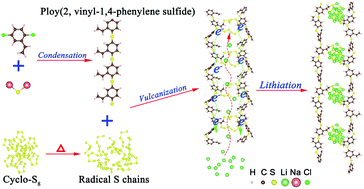An inverse vulcanized conductive polymer for Li–S battery cathodes†
Abstract
Polymers with a broad range of properties, structural diversity, and mechanical flexibility have been adopted in all aspects of Li–S batteries. However, currently explored polymers for Li–S cathodes suffer from low conductivity, low S content, and poor cycling performance. In this first-principles study, we theoretically design a new polymer, poly(2-vinyl,1,4-phenylene sulfide), by modifying the conductive poly(1,4-phenylene sulfide) via the vinyl group to enhance its ability to vulcanize with element S. We compare the properties of the experimentally realized sulfur vulcanized polymers via condensation and our designed sulfur vulcanized polymers via crosslinking as Li–S battery cathodes, in terms of gravimetric and specific capacities, as well as structural stability during the lithiation. Overall, we find that our designed polymer possesses better conductivity, higher specific capacity and gravimetric energy density, and better kinetic stability, and restricts the shuttle effect more efficiently than the current experimentally explored one. Also, the cross-linked sulfur compounds can be activated efficiently due to the short transport lengths rather than dissolution in the electrolyte during battery operation. Therefore, we believe our designed polymer cathode is promising for practical applications.



 Please wait while we load your content...
Please wait while we load your content...